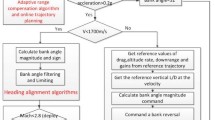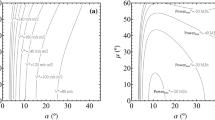Abstract
This paper is concerned with guidance strategies and piloting techniques which ensure near-optimum performance and maximum survival capability in a severe windshear. The take-off problem is considered with reference to flight in a vertical plane. In addition to the horizontal shear, the presence of a downdraft is assumed.
First, six particular guidance schemes are considered, namely: constant alpha guidance; maximum alpha guidance; constant velocity guidance; constant absolute path inclination guidance; constant rate of climb guidance; and constant pitch guidance. Among these, it is concluded that the best one is the constant pitch guidance.
Next, in an effort to improve over the constant pitch guidance, three additional trajectories are considered: the optimal trajectory, which minimizes the maximum deviation of the absolute path inclination from a reference value, while employing global information on the wind flow field; the gamma guidance trajectory, which is based on the absolute path inclination and which approximates the behavior of the optimal trajectory, while employing local information on the windshear and the downdraft; and the simplified gamma guidance trajectory, which is the limiting case of the gamma guidance trajectory in a severe windshear and which does not require precise information on the windshear and the downdraft.
The essence of the simplified gamma guidance trajectory is that it yields a quick transition to horizontal flight. Comparative numerical experiments show that the survival capability of the simplified gamma guidance trajectory is superior to that of the constant pitch trajectory and is close to that of the optimal trajectory.
Next, with reference to the simplified gamma guidance trajectory, the effect of the feedback gain coefficient is studied. It is shown that larger values of the gain coefficient improve the survival capability in a severe windshear; however, excessive values of the gain coefficient are undesirable, because they result in larger altitude oscillations and lower average altitude.
Finally, with reference to the simplified gamma guidance trajectory, the effect of time delays is studied, more specifically, the time delay τ1 in reacting to windshear onset and the time delay τ2 in reacting to windshear termination. While time delay τ2 has little effect on survival capability, time delay τ1 appears to be critical in the following sense: smaller values of τ1 correspond to better survival capability in a severe windshear, while larger values of τ1 are associated with a worsening of the survival capability in a severe windshear.
Similar content being viewed by others
References
Fujita, T. T.,The Downburst, Department of Geophysical Sciences, University of Chicago, Chicago, Illinois, 1985.
Anonymous, N. N.,Aircraft Accident Report: Pan American World Airways, Clipper 759, Boeing 727-235, N4737, New Orleans International Airport, Kenner, Louisiana, July 9, 1982, Report No. NTSB-AAR-8302, National Transportation Safety Board, Washington, DC, 1983.
Anonymous, N. N.,Aircraft Accident Report: Delta Air Lines, Lockheed L-1011-3851, N726DA, Dallas-Forth Worth International Airport, Texas, August 2, 1985, Report No. NTSB-AAR-8605, National Transportation Safety Board, Washington, DC, 1985.
Fujita, T. T.,DFW Microburst, Department of Geophysical Sciences, University of Chicago, Chicago, Illinois, 1986.
Miele, A., Wang, T., andMelvin, W. W.,Optimal Flight Trajectories in the Presence of Windshear, Parts 1–4, Rice University, Aero-Astronautics Reports Nos. 191–194, 1985.
Miele, A., Wang, T., andMelvin, W. W.,Optimal Take-Off Trajectories in the Presence of Windshear, Journal of Optimization Theory and Applications, Vol. 49, No. 1, pp. 1–45, 1986.
Psiaki, M. L., andStengel, R. F.,Optimal Flight Paths through Microburst Wind Profiles, Journal of Aircraft, Vol. 23, No. 8, pp. 629–635, 1986.
Frost, W.,Flight in Low Level Windshear, NASA, Contractor Report No. 3678, 1983.
Psiaki, M. L., andStengel, R. F.,Analysis of Aircraft Control Strategies for Microburst Encounter, Paper No. AIAA-84-0238, AIAA 22nd Aerospace Sciences Meeting, Reno, Nevada, 1984.
Miele, A., Wang, T., andMelvin, W. W.,Guidance Strategies for Near-Optimum Performance in a Windshear, Parts 1–2, Rice University, Aero-Astronautics Reports Nos. 201–202, 1986.
Miele, A., Wang, T., andMelvin, W. W.,Guidance Strategies for Near-Optimum Take-off Performance in a Windshear, Journal of Optimization Theory and Applications, Vol. 50, No. 1, pp. 1–47, 1986.
Miele, A., Wang, T., andMelvin, W. W.,Optimization and Acceleration Guidance of Flight Trajectories in a Windshear, Paper No. AIAA-86-2036, AIAA Guidance, Navigation, and Control Conference, Williamsburg, Virginia, 1986.
Miele, A., Wang, T., andMelvin, W. W.,Optimization and Gamma/Theta Guidance of Flight Trajectories in a Windshear, Paper No. ICAS-86-564, 15th Congress of the International Council of the Aeronautical Sciences, London, England, 1986.
Anonymous, N. N.,Flight Path Control in Windshear, Boeing Airliner, pp. 1–12, January–March 1985.
Zhu, S. X., andEtkin, B.,Fluid-Dynamic Model of a Downburst, University of Toronto, Institute for Aerospace Studies, Report No. UTIAS-271, 1983.
Alexander, M. B., andCamp, D. W.,Wind Speed and Direction Shears with Associated Vertical Motion during Strong Surface Winds, NASA, Technical Memorandum No. 82566, 1984.
Frost, W., Chang, H. P., Elmore, K. L., andMcCarthy, J.,Simulated Flight through JAWS Windshear: In-Depth Analysis Results, Paper No. AIAA-84-0276, AIAA 22nd Aerospace Sciences Meeting, Reno, Nevada, 1984.
Michael, G. J.,Computation of Chebyshev Optimal Control, AIAA Journal, Vol. 9, No. 5, pp. 973–975, 1971.
Miele, A., andWang, T.,An Elementary Proof of a Functional Analysis Result Having Interest for Minimax Optimal Control of Aeroassisted Orbital Transfer Vehicles, Rice University, Aero-Astronautics Report No. 182, 1985.
Gonzalez, S., andMiele, A.,Sequential Gradient-Restoration Algorithm for Optimal Control Problems with General Boundary Conditions, Journal of Optimization Theory and Applications, Vol. 26, No. 3, pp. 395–425, 1978.
Miele, A.,Gradient Algorithms for the Optimization of Dynamic Systems, Control and Dynamic Systems, Advances in Theory and Application, Edited by C. T. Leondes, Academic Press, New York, New York, Vol. 16, pp. 1–52, 1980.
Miele, A., andWang, T.,Primal-Dual Properties of Sequential Gradient-Restoration Algorithms for Optimal Control Problems, Part 1, Basic Problem, Integral Methods in Science and Engineering, Edited by A. Haji-Sheikh, Hemisphere Publishing Corporation, Washington, DC, pp. 577–607, 1986.
Miele, A., andWang, T.,Primal-Dual Properties of Sequential Gradient-Restoration Algorithms for Optimal Control Problems, Part 2, General Problem, Journal of Mathematical Analysis and Applications, Vol. 119, Nos. 1–2, pp. 21–54, 1986.
Author information
Authors and Affiliations
Additional information
This research was supported by NASA-Langley Research Center, Grant No. NAG-1-516, and by Boeing Commercial Airplane Company.
Rights and permissions
About this article
Cite this article
Miele, A., Wang, T., Melvin, W.W. et al. Maximum survival capability of an aircraft in a severe windshear. J Optim Theory Appl 53, 181–217 (1987). https://doi.org/10.1007/BF00939214
Issue Date:
DOI: https://doi.org/10.1007/BF00939214




